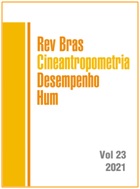Acute effects of a walking activity on plantar pressure in children with obesity
DOI:
https://doi.org/10.1590/1980-0037.2021v23e78684Abstract
Children with obesity present greater foot loads during walking when compared to eutrophic ones. However, the acute effects of a moderate walking on the distribution of plantar pressure in children with obesity are still incipient in the literature. Our aim was to verify the acute effects of six-minute walk test on plantar pressure in obese and eutrophic children. A pressure platform was used to record plantar pressure during walking for 62 children (37 girls), aged 7-10 years old, before and after the six-minute walk test. Children were divided into an obese group - OB (n = 20), and an eutrophic group - EU (n = 42). Peak plantar pressure (PPP), maximum force (MF), and contact area (CA) were assessed in three trials during walking at a comfortable speed. The analyses were performed in five plantar regions: rearfoot, midfoot, forefoot, hallux, and toes. For the PPP was higher under the midfoot region of the OB group after walking. In the comparison between groups, PPP, MF, and CA were higher for the OB group for most regions. We concluded that, after a moderate walking activity, children with obesity experience an increase in plantar loads, especially under the midfoot, which can bring greater discomfort and risk of injuries.
References
Castillo JJ, Hazlett ZS, Orlando RA, Garver WS. A global evolutionary and metabolic analysis of human obesity gene risk variants. Gene 2017;627:412-419.
Pogodina A, Rychkova L, Kravtzova O, Klimkina J, Kosovtzeva A. Cardiometabolic risk factors and health-related quality of life in adolescents with obesity. Child Obes 2017;13(6):499-506.
Umer A, Kelley GA, Cottrell LE, Jr PG, Innes KE, Lilly CL. Childhood obesity and adult cardiovascular disease risk factors: a systematic review with meta-analysis. BMC Public Health 2017;17(683):1-24.
O'Malley G, Ring-dimitriou S. Physical activity and physical fitness in pediatric obesity : what are the first steps for clinicians? Expert conclusion from the 2016 ECOG workshop. Int J Exerc Sci 2017; 10(4), 487-496.
Shultz SP, Byrne NM, Hills AP. Musculoskeletal function and obesity: implications for physical activity. Curr Obes Rep 2014;3(3):355-360.
Jankowicz-Szymanska A, Mikolajczyk E, Wodka K. Correlations among foot arching, ankle dorsiflexion range of motion, and obesity level in primary school. J Am Podiatr Med Assoc 2017;107(2):130-136.
Dufek JS, Mercer JA, Gouws P-L, Candela L, Gutierrez AP, Mercer JA, Putney LG. Effects of overweight and obesity on walking characteristics in adolescents. Hum Mov Sci 2012;31(4):897-906.
Mesquita P, Neri S, Lima RM, Carpes FP, de David AC. Childhood obesity is associated with altered plantar pressure distribution during running. Gait Posture 2018;62:202-205.
Song-Hua Y, Lu W, Kuan Z. Effects of different movement modes on plantar pressure distribution patterns in obese and non-obese Chinese children. Gait Posture 2017;57:28-34.
Mueller S, Carlsohn A, Mueller J, Baur H, Mayer F. Influence of obesity on foot loading characteristics in gait for children aged 1 to 12 years. PLoS One 2016;11(2):1-12.
Mickle KJ, Steele JR, Munro BJ. Does excess mass affect plantar pressure in young children? Int J Pediatr Obes 2006;1(3):183-188.
Petridou A, Siopi A, Mougios V. Exercise in the management of obesity. Metab Clin Exp 2019;92:163-169.
Vie B, Griffon P, Bijoux A, Cadiere J, Paul J, Jammes Y. Effect of the 6-minute walk test on plantar loading and capability to produce ankle plantar flexion forces. Gait Posture 2016;49:61-66.
Escudero-Uribe S, Hochsprung A, Izquierdo-Ayuso G. Gait pattern changes after six-minute walk test in persons with multiple sclerosis. Physiother Res Int 2018:1-10.
Cacau LAP, Carvalho VO, Pin AS, Daniel CRA, Ikeda DS, de Carvalho EM, et al. Reference values for the 6-min walk distance in healthy children age 7 to 12 years in Brazil: main results of the TC6min Brasil multi-center study. Respir Care 2018;6(3):339-346.
Morinder G. Six-minute walk test in obese children and adolescents: reproducibility and validity. Physiother Res Int 2009;14:91-104.
Cole TJ, Bellizzi MC, Flegal KM, Dietz WH. Establishing a standard definition for child overweight and obesity worldwide: international survey. Br Med J 2000;320:1-6.
Lohman TG, Roche AF, Martorell R. Skinfold thicknesses and measurement technique. In: Anthropometric standardization reference manual. 1988, Human Kinetics Book, Champlain, 55–80.
Rosenbaum D, Hautmann S, Gold M, Claes L. Effects of walking speed on plantar pressure patterns and hindfoot angular motion. Gait Posture 1994;2:191-197.
Cavanagh PR, Rodgers MM. The arch index: a useful measure from footprints. J Biomech 1987;20(5):547-551
Menz HB. Two feet, or one person? Problems associated with statistical analysis of paired data in foot and ankle medicine. Foot 2004;14:2-5.
Buldt AK, Forghany S, Landorf KB, Levingere P, Murley GS, Menz HB. Foot posture is associated with plantar pressure during gait: a comparison of normal, planus and cavus feet. Gait Posture 2018;62:235-340.
Putti AB, Arnold GP, Cochrane LA, Abboud RJ. Normal pressure values and repeatability of the Emed ST4 system. Gait Posture 2008;27:501-505.
American Thoracic Society. ATS statement: guidelines for the six-minute walk test. Am J Respir Crit Care Med 2002;166:111-117.
Borg GAV. Psychophysical bases of perceived exertion. Med Sci Sport Exerc 1982;14(5):377-381.
Fourchet F, Kelly L, Horobeanu C, Loepelt H, Taiar R. High-intensity running and plantar-flexor fatigability and plantar-pressure distribution in adolescent runners. Gait Posture 2015;50(2):117-125.
Zhao Y, Zheng D, Yan S, Liu M, Yang L. Children with obesity experience different age-related changes in plantar pressure distributions: a follow-up study in China. Int J Environ Res Public Health 2020;17(6602):1-10.
Catan L, Amaricai E, Onofrei RR, Popoiu CM, Lacob ER, Stanciulescu CM, et al. The impact of overweight and obesity on plantar pressure in children and adolescents: a systematic review. Int J Environ Res Public Health 2020;17(6600):1-21.
Li AM. The six-minute walk test in healthy children: reliability and validity. Eur Respir J. 2005;25(6):1057-1060.
Casonatto J, Joa M, Ricardo E, Ronque V. Association between health-related physical fitness and body mass index status in children. J Child Heal Care 2015:1-10.



